Object-Oriented Design & Patterns
Cay S. Horstmann
Chapter 3
The Object-Oriented Design Process

Slide navigation: Forward with space bar, → arrow key, or PgDn. Backwards with ← or PgUp.
Chapter Topics
- An overview of the date and time classes in the Java library
- Designing a Day class
- Three implementations of the Day class
- The importance of encapsulation
- Analyzing the quality of an interface
- Programming by contract
- Unit testing
Date/Time Classes in the Standard Library
Points in Time

Methods of the Instant class
| Method |
Description |
long getEpochSecond() |
Gets the number of seconds since the epoch. |
long getNano() |
Gets the number of nanoseconds since the last second. |
Instant plusSeconds(long seconds)
Instant plusNanos(long nanos) |
Yields the instant that is obtained by adding the given number of seconds or nanoseconds. |
Instant plus(Duration duration) |
Yields the instant that is obtained by adding the given Duration (which encapulates seconds and nanoseconds). |
ZonedDateTime atZone(ZoneId zone) |
Yields the ZonedDateTime at a given time zone. You get a ZoneId with its static of method, such as ZoneId.of("America/Los_Angeles"). |
String toString() |
Yields a representation in ISO-8601 format. |
The ZonedDateTime Class
- The
Instant class doesn't measure months, weekdays, etc.
- That's the job of a calendar
- A calendar assigns a name to a point in time
- Many calendars in use:
- Gregorian
- Contemporary: Hebrew, Arabic, Chinese
- Historical: French Revolutionary, Mayan
- The
ZonedDateTime class uses the Gregorian calendar, and it knows about time zones.
- Legacy classes
Date, GregorianCalendar
Methods of the ZonedDateTime Class
| Method |
Description |
int getYear()
int getMonthValue()
int getDayOfMonth() |
Gets the year, month, or day. |
DayOfWeek getDayOfWeek() |
Gets the day of the week. Call the value method on the returned object to get an integer value (1 = Monday ... 7 = Sunday). |
int getHour()
int getMinute()
int getSecond()
int getNano() |
Gets the hour, minute, second, or nanosecond of this
ZonedDateTime. |
ZoneOffset getOffset() |
Gets the offset from the zero meridian. Call getTotalSeconds on the returned object to get the offset in seconds. |
ZonedDateTime plusDays(int n)
ZonedDateTime plusWeeks(int n)
ZonedDateTime plusMonths(int n)
ZonedDateTime
plusYears(int n)
ZonedDateTime plusHours(int n)
ZonedDateTime plusMinutes(int n)
ZonedDateTime plusSeconds(int n)
ZonedDateTime plusNanos(int n) |
Yields a ZonedDateTime that is obtained by adding a the given number of days, weeks, months, years, hours, minutes, seconds, or nanoseconds temporal units to this ZonedDateTime. |
Designing a Day Class
- Custom class, for teaching/learning purpose
- Use the standard library classes, not this class, in your own programs
Day encapsulates a day in a fixed location - No time, no time zone
- Use Gregorian calendar
Designing a Day Class
- Answer questions such as
- How many days are there between now and the end of the year?
- What day is 100 days from now?
Designing a Day Class
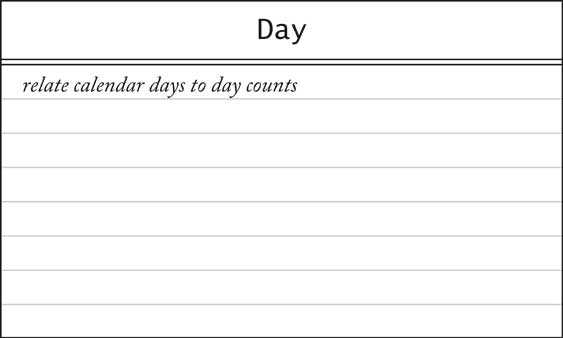
Designing a Day Class
daysFrom computes number of days between two days:
int n = today.daysFrom(birthday);
plusDays computes a day that is some days away from a given day:
Day later = today.plusDays(999);
- Mathematical relationship:
d.plusDays(n).daysFrom(d) == n
d1.plusDays(d2.daysFrom(d1)) == d2
- Clearer when written with "overloaded operators":
(d + n) - d == n
d1 + (d2 - d1) == d2
- Constructor
Date(int year, int month, int dayOfMonth)
getYear, getMonth, getDayOfMonth acccesors
Implementing a Day Class
Implementing a Day Class
Second Implementation
- For greater efficiency, use Julian day number
- Used in astronomy
- Number of days since Jan. 1, 4713 BCE
- May 23, 1968 = Julian Day 2,440,000
- Greatly simplifies date arithmetic
- ch03/../../code/ch03/day2/Day.java
Third Implementation
The Importance of Encapsulation
- Even a simple class can benefit from different implementations
- Users are unaware of implementation
- Public instance variables would have blocked improvement
- Don't use public fields, even for "simple" classes
Accessors and Mutators
- Mutator: Changes object state
- Accessor: Reads object state without changing it
Day class has no mutators! - Class without mutators is immutable
String is immutable Date and GregorianCalendar are mutable
Don't Supply a Mutator for every Accessor
Day has getYear, getMonth, getDayOfMonth accessors Day does not have setYear, setMonth,setDayOfMonth mutators - These mutators would not work well
- Example:
Day deadline = new Day(2001, 1, 31);
deadline.setMonth(2); // ERROR
deadline.setDayOfMonth(28);
- Maybe we should call
setDayOfMonth first?
Day deadline = new Day(2001, 2, 28);
deadline.setDayOfMonth(31); // ERROR
deadline.setMonth(3);
GregorianCalendar implements confusing rollover.
- Silently gets the wrong result instead of error.
- Immutability is useful
Sharing Mutable References
Sharing Mutable References
Sharing Mutable References
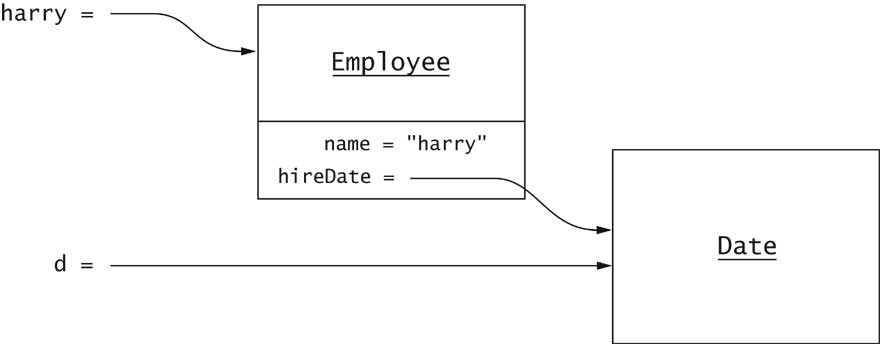
Final Instance Fields
- Good idea to mark immutable instance fields as
final
private final int day;
final object reference can still refer to mutating object
private final ArrayList elements; elements can't refer to another array list
- The contents of the array list can change
Separating Accessors and Mutators
Separating Accessors and Mutators
Side Effects
- Side effect of a method: any observable state change
- Mutator: changes implicit parameter
- Other side effects: change to
- explicit parameter
- static object
- Avoid these side effects--they confuse users
- Good example, no side effect beyond implicit parameter
a.addAll(b)
mutates a but not b
Side Effects
- Date formatting (basic):
SimpleDateFormat formatter = . . .;
String dateString = "January 11, 2012";
Date d = formatter.parse(dateString);
- Advanced:
FieldPosition position = . . .;
Date d = formatter.parse(dateString, position);
- Side effect: updates
position parameter
- Design could be better: add position to formatter state
Side Effects
Law of Demeter
- Example: Mail system in chapter 2
Mailbox currentMailbox = mailSystem.findMailbox(...);
- Breaks encapsulation
- Suppose future version of
MailSystem uses a database
- Then it no longer has mailbox objects
- Common in larger systems
- Karl Lieberherr: Law of Demeter
- Demeter = Greek goddess of agriculture, sister of Zeus
Law of Demeter
Quality of Class Interface
- Customers: Programmers using the class
- Criteria:
- Cohesion
- Completeness
- Convenience
- Clarity
- Consistency
- Engineering activity: make tradeoffs
Cohesion
Completeness
Convenience
Clarity
- Confused programmers write buggy code
- Bad example: Removing elements from
LinkedList
- Reminder: Standard linked list class
LinkedList<String> countries = new LinkedList<String>();
countries.add("A");
countries.add("B");
countries.add("C");
- Iterate through list:
ListIterator<String> iterator = countries.listIterator();
while (iterator.hasNext())
System.out.println(iterator.next());
Clarity
Consistency
Consistency
- Bad example:
String class
s.equals(t) / s.equalsIgnoreCase(t)
- But
boolean regionMatches(int toffset,
String other, int ooffset, int len)
boolean regionMatches(boolean ignoreCase, int toffset,
String other, int ooffset, int len)
- Why not
regionMatchesIgnoreCase?
- Very common problem in student code
Programming by Contract
- Spell out responsibilities
- Increase reliability
- Increase efficiency
Preconditions
- Caller attempts to remove message from empty
MessageQueue
- What should happen?
MessageQueue can declare this as an error MessageQueue can tolerate call and return dummy value - What is better?
Preconditions
- Excessive error checking is costly
- Returning dummy values can complicate testing
- Contract metaphor
- Service provider must specify preconditions
- If precondition is fulfilled, service provider must work correctly
- Otherwise, service provider can do anything
- When precondition fails, service provider may
- throw exception
- return false answer
- corrupt data
Preconditions
/**
Remove message at head
@return the message at the head
@precondition size() > 0
*/
Message remove()
{
return elements.remove(0);
}
- What happens if precondition not fulfilled?
IndexOutOfBoundsException - Other implementation may have different behavior
Circular Array Implementation
- Efficient implementation of bounded queue
- Avoids inefficient shifting of elements
- Circular: head, tail indexes wrap around
- ch03/queue/MessageQueue.java
Inefficient Shifting of Elements
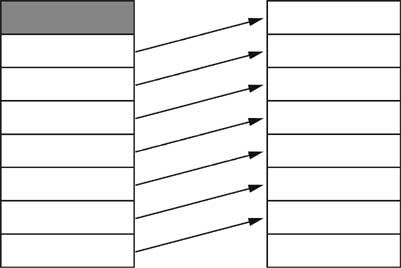
A Circular Array
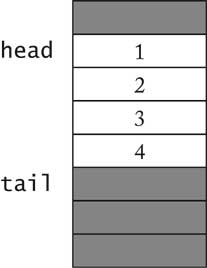
Wrapping around the End
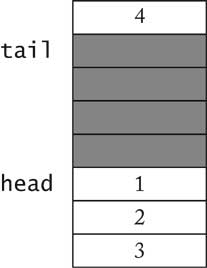
Preconditions
- In circular array implementation, failure of
remove precondition corrupts queue!
- Bounded queue needs precondition for
add
- Naive approach:
@precondition size() < elements.length
- Precondition should be checkable by caller
- Better:
@precondition size() < getCapacity()
Assertions
Assertions
public Message remove()
{
assert count > 0 : "violated precondition size() > 0";
Message r = elements[head];
. . .
}
Exceptions in the Contract
/**
. . .
@throws NoSuchElementException if queue is empty
*/
public Message remove()
{
if (count == 0)
throw new NoSuchElementException();
Message r = elements[head];
. . .
}
- Exception throw part of the contract
- Caller can rely on behavior
- Exception throw not result of precondition violation
- This method has no precondition
Postconditions
Class Invariants
- Condition that is
- true after every constructor
- preserved by every method
(if it's true before the call, it's again true afterwards)
- Useful for checking validity of operations
Class Invariants
Unit Testing
- Unit test = test of a single class
- Design test cases during implementation
- Run tests after every implementation change
- When you find a bug, add a test case that catches it
JUnit
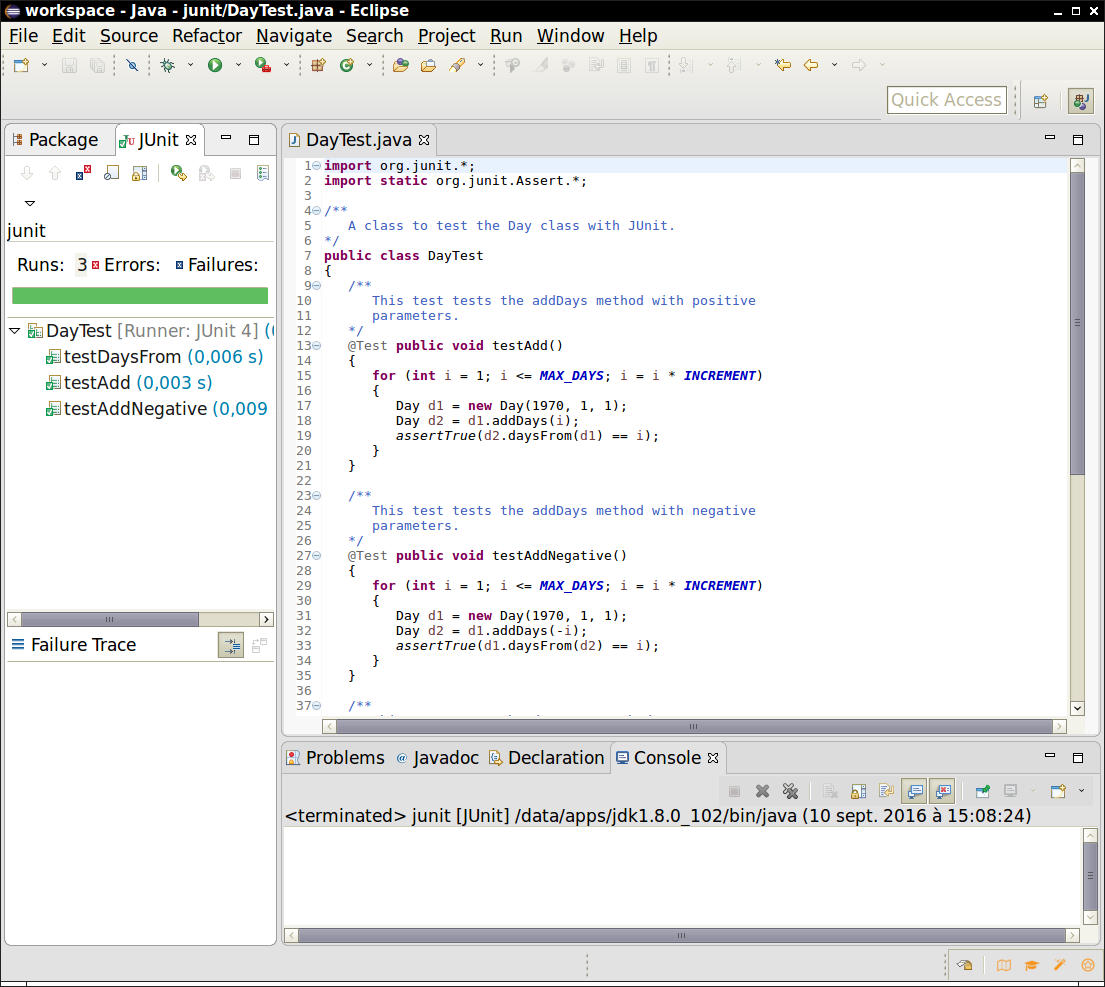
JUnit
- Annotate test methods with
@Test
- Follow this outline:
import org.junit.*;
import static org.junit.Assert.*;
public class DayTest
{
@Test public void testAdd() { ... }
@Test public void testDaysBetween() { ... }
. . .
}
JUnit
- Each test case checks a condition by calling one of the static methods from the
Assert class.
- Test framework catches assertion failures
@Test public void testAdd()
{
Day d1 = new Day(1970, 1, 1);
int n = 1000;
Day d2 = d1.plusDays(n);
assertTrue(d2.daysFrom(d1) == n);
}







